Related Research Articles
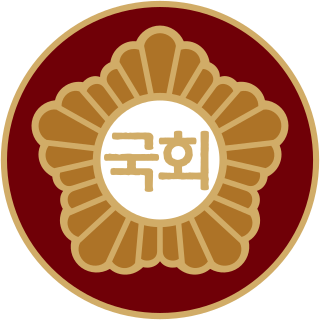
The National Assembly of the Republic of Korea, often shortened to the National Assembly in domestic English-language media, is the unicameral national legislature of South Korea. Elections to the National Assembly are held every four years. The latest legislative elections were held on 15 April 2020. The National Assembly has 300 seats, with 253 constituency seats and 47 proportional representation seats; 30 of the PR seats are assigned on additional member system, while 17 PR seats use the parallel voting method.
Elections in South Korea are held on a national level to select the President and the National Assembly. Local elections are held every four years to elect governors, metropolitan mayors, municipal mayors, and provincial and municipal legislatures.

The president of the State Affairs Commission of the Democratic People's Republic of Korea is the head of state of North Korea. The president chairs the State Affairs Commission (SAC), which is the highest leadership institution in North Korea, and serves as the commander-in-chief of the North Korean armed forces.

Legislative elections were held in South Korea on 13 April 2016. All 300 members of the National Assembly were elected, 253 from first-past-the-post constituencies and 47 from proportional party lists. The election was an upset victory for the liberal Democratic Party, which defied opinion polling by winning a plurality of seats in the election and defeating the ruling conservative Saenuri Party by one seat. In votes for party lists, however, Democratic Party came third, behind the Saenuri Party in first place and the new People Party in second.

The New Democratic Party was a South Korean opposition party that existed from 1967 to 1980, when it was forcibly dissolved by the ninth amendment of the constitution promulgated by Chun Doo-hwan the same year. It was the main opposition party during the Park Chung-hee dictatorial regime, and especially since 1972, when the Yushin constitution was put into effect.

Legislative elections were held in South Korea on 15 April 2020. All 300 members of the National Assembly were elected, 253 from first-past-the-post constituencies and 47 from proportional party lists. They were the first elections held under a new electoral system. The two largest parties, the liberal Democratic Party and the conservative United Future Party, set up new satellite parties to take advantage of the revised electoral system. The reforms also lowered the voting age from 19 to 18.
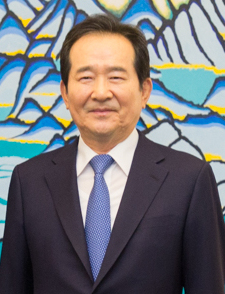
Chung Sye-kyun is a South Korean politician who has served as Speaker of the National Assembly from 2016 to 2018 and Prime Minister of South Korea from 2020 to 2021.
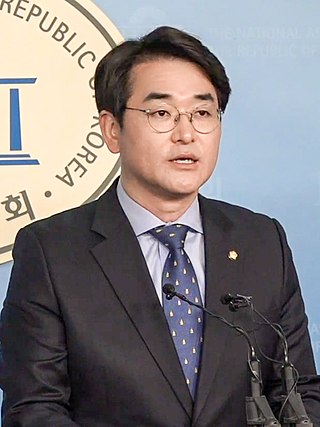
Park Yong-jin is a South Korean labor activist and politician in the liberal Minjoo Party of Korea. He was elected member of the National Assembly for Gangbuk, Seoul, in the April 2016 parliamentary elections.
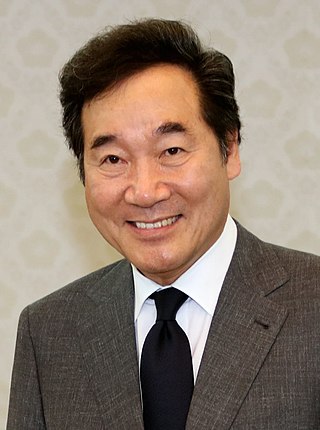
Lee Nak-yon, also known as Lee Nak-yeon, is a South Korean politician who served as the 41st Prime Minister of South Korea from 2017 to 2020. A member of the Democratic Party of Korea, he is the longest-serving prime minister since the Constitution of South Korea was last revised in 1987. Lee previously held the governorship of Jeollanam-do province from 2014 to 2017, a stronghold of his party. Before serving as governor, he worked as a journalist for over 20 years and served as a member of the National Assembly for four terms.
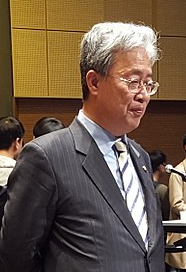
Yu Sung-yup is a South Korean politician who was the Member of the National Assembly for Jeongeup from 2008 to 2020. He was also the co-presidents of the Minsaeng Party, serving with Park Joo-hyun. He formerly served the mayor of Jeongeup from 2002 to 2006. As a former member of the Party for Democracy and Peace, he was the party's vice president from 2018 to 2019 and the parliamentary leader from May to August 2019.

Nam In-soon is a South Korean activist and feminist politician, currently a member of National Assembly representing Songpa C constituency. In August 2018, she was elected as one of the Vice Presidents of Democratic Party of Korea.

The People Power Party, formerly known as the United Future Party, is a conservative political party in South Korea. Controlling the South Korean presidency, it is the second largest party in the National Assembly. PPP, along with its historic rival, the Democratic Party, make up the two largest political parties in South Korea.
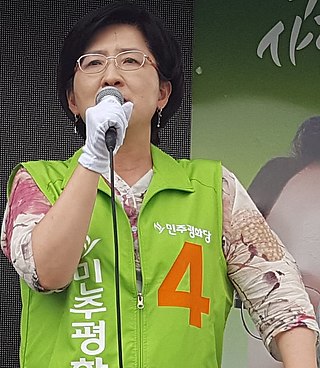
Park Joo-hyun is a South Korean lawyer and politician. She is the incumbent Member of the National Assembly since 2016 and was also one of the co-Presidents of the Minsaeng Party in 2020, serving with Yu Sung-yup.
West District and East District Busan is a constituency in Busan represented in the National Assembly of the Republic of Korea. It is one of the 253 constituencies that elects one assembly member by the first past the post system of election, and was created before the 2016 South Korean legislative election. It is currently represented by Yu Gu-jun of the United Future Party. He represented West District Busan, one of the seats predecessor seats from 2004 to 2016. Like most seats in Busan the seat and its predecessors have been safe seats for the United Future Party and its predecessor parties.
Kim Jong-hoon is a South Korean politician. He is the current Floor Leader of the Minjung Party. He was the only Minjung Party member in the National Assembly until he lost his seat in the 2020 elections.

Yun So-ha also written as Youn So-ha is a South Korean politician that is a member of the National Assembly and served as the Floor Leader of the Justice Party.
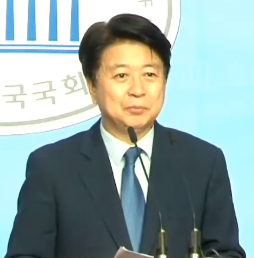
Noh Woong-rae is a South Korean politician serving as a member of the National Assembly that represents the Mapo A constituency. He is a member of the liberal Democratic Party of Korea. Noh is part of the anti-Moon Jae-in faction within the Democratic Party of Korea.
Kim Jae-yeon is a South Korean politician and former activist. She was the Leader of the Progressive Party from 2020 to 2022. She was also the former Member of the National Assembly from 2012 to 2014, as well as their Presidential candidate during the 2022 South Korean presidential election.

Kim Jinai, also known as Kim Jin-ae, is a South Korean urban engineer and politician.

Choo Kyung-ho is a South Korean government official and politician. He is the Deputy Prime Minister and Minister of Economy and Finance under the Yoon Suk Yeol government. He has been serving as the Member of the National Assembly for Dalseong since 2016.
References
- ↑ "대한민국의_국회의원_선거구_목록" . Retrieved 9 April 2020.
- ↑ "대한민국 제21대 국회의원 선거 선거구 획정" . Retrieved 9 April 2020.
- ↑ National Election Commission (South Korea). "(21st National Assembly) Electoral Districts and Divisions - Seoul" (PDF).